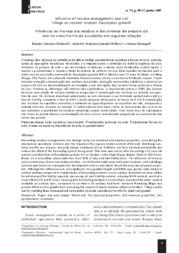Influence of residue management and soil tillage on second rotation Eucalyptus growth.
Influence of residue management and soil tillage on second rotation Eucalyptus growth.
Autoria: DEDECEK, R. A.; BELLOTE, A. F. J.; MENEGOL, O.
Resumo: O manejo dos resíduos da colheita pode alterar muitas características químicas e físicas do solo, considerando as operações mecânicas envolvidas e o impacto sobre o conteúdo da matéria orgânica do solo. Sistemas de preparo do solo e uso de resíduos celulósicos e cinzas como fertilizantes podem ajudar a manter a produtividade e reduzir o efeito do sistema de colheita em uso. Este trabalho foi iniciado após o corte raso de um plantio comercial de Eucalyptus grandis Hill ex Maiden com 12 anos de idade, em Mogi Guaçu, São Paulo, em Latossolo Vermelho-Amarelo textura média e com baixa fertilidade natural. Foram testadas remoção e manutenção dos resíduos da colheita, adubação com resíduo celulósico e sistemas de preparo do solo no desenvolvimento do eucalipto e nas alterações das características químicas e físicas do solo. Embora as diferenças não tenham sido significativas, o crescimento (altura e DAP) das árvores foi maior com adição de resíduo celulósico comparado à manutenção dos resíduos da colheita na superfície do solo. Os resíduos industriais adicionados ao solo alteraram a sua fertilidade aumentando o pH e o teor de Ca+Mg, reduzindo o teor de Al+H e tendo pequeno efeito sobre os teores de K e P. A manutenção dos resíduos na superfície aumentou o conteúdo de água disponível na superfície do solo, comparado à retirada total dos resíduos da colheita. O cultivo mínimo teve maior efeito no crescimento das árvores do que aumentar a quantidade de resíduos industriais usados como adubo. Uma maior faixa de subsolagem nas linhas de plantio elevou a compactação do solo a níveis considerados prejudiciais ao crescimento das raízes das plantas. Harvesting residue management can change many soil chemical and physical properties, considering the mechanical operations involved and the impact on the organic matter content of the soil. Soil tillage systems and the use of paper and pulp sludge and wood ash as fertilizers can help maintain productivity and reduce the effect of the harvesting system being used. This work was set up after harvesting a 12 year old commercial plantation of Eucalyptus grandis Hill ex Maiden, in the Mogi Guaçu district, State of São Paulo, Brazil, on a red-yellow latosol with less than 25% of clay and low fertility level. The influence of removal and maintenance of tree harvesting residues, soil fertilization with pulp and paper residues, and soil tillage systems was tested on eucalypts tree development and on alterations of soil chemical and physical properties. Although the difference was not significant, tree growth (height and DBH) was greater with industrial residue addition compared to maintenance of harvesting residues on soil surface. Industrial residues added to soil changed the fertility capacity, increasing pH and Ca+Mg content, reducing H+Al content, and had a small effect on K and P levels. Keeping tree-harvesting residues on soil surface increased the water content available on surface layer, compared to soil where all residues had been removed. Reducing tillage had greater effect on tree growth than increasing the amount of waste material added as fertilizer. Tilling a wider row for planting lines increased soil compaction at levels considered harmful for plant root growth.
Ano de publicação: 2007
Tipo de publicação: Artigo de periódico
Unidade: Embrapa Florestas
Palavras-chave: Física, Lodo celulósico, Química, Solo
Observações
1 - Por padrão são exibidas publicações dos últimos 20 anos. Para encontrar publicações mais antigas, configure o filtro ano de publicação, colocando o ano a partir do qual você deseja encontrar publicações. O filtro está na coluna da esquerda na busca acima.
2 - Para ler algumas publicações da Embrapa (apenas as que estão em formato ePub), é necessário ter, no celular ou computador, um desses softwares gratuitos. Sistemas Android: Google Play Livros; IOS: iBooks; Windows e Linux: software Calibre.
Acesse outras publicações
Acesse a Base de Dados da Pesquisa Agropecuária (BDPA) para consultar o acervo completo das bibliotecas da Embrapa.

